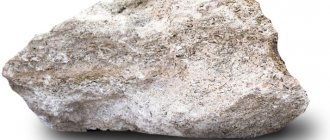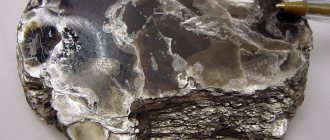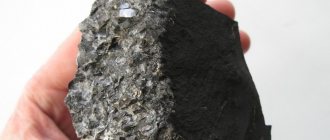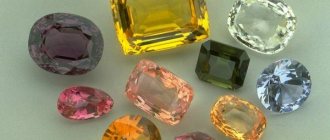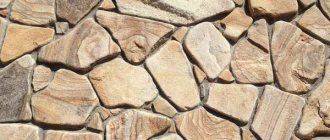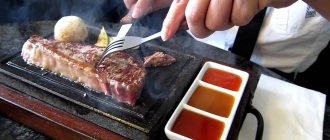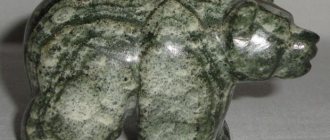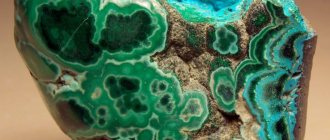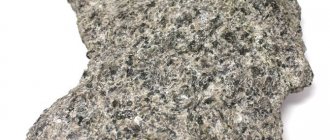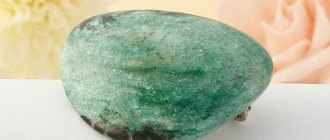Cryolite was known to the Eskimos long before its discovery by Europeans. The name of the mineral comes from the Greek “krios” - ice and lithos - stone (ice stone) (d'Andrada, 1800); first reliably studied by Abilgard (1799).
The English name of the mineral is Cryolite
Synonyms: Ice stone - Eisstein (Glocker, 1831), orsugisat - Orsugisat - local designation in Greenland, meaning “fat salt” (according to Hinze); corresponds to artificial α-cryolite.
Cryolite
Formula
Na3AlF6
Chemical composition
Chemical theoretical composition: Na - 32.86; Al - 12.84; F - 54.30%. There are no chemical analyzes of cryolite that fully meet modern requirements; the limits of fluctuations in composition and the possibility of isomorphic occurrence of various elements in the crystal lattice of the mineral have not been established. Most analyzes detect a discrepancy between the amounts of cations and anions. More often a deficiency of F is detected, less often - its excess. The Na:Al ratio never corresponds to the theoretical one and in most analyzes ranges from 2.92 to 2.99 (0.36 - 0.04 wt.% Na below theoretical). These results are likely due to imperfect analysis methods. The discrepancies between the theoretical composition and analyzes of synthetic and natural minerals performed during various physicochemical and technological studies are especially large. Various variations of the cryolite formula have been proposed. Isomorphism is possible between high-temperature β-cryolite and isostructural compounds K3AlF6 and elpasolite (K2NaAlF6); in cryolite from the Ilmen Mountains, 0.08% K was discovered by flame photometry, and in cryolite from Tuva - 0.0028 Li2O, 0.0008 Rb2O and 0.0008 Cs2O, 0.07% K, 0.007 Li2O, 0.0003 Rb2O , Seine discovered. The often observed Ca is probably due to the presence of admixtures of other minerals, although Nöllner and Lemberg assumed an isomorphic replacement of sodium with calcium. Often observed in the mineral, Si and Mg are due to impurities of other minerals, and increased amounts of Li are due to the presence of cryolithionite.
Crystallographic characteristics
Syngony. Monoclinic. L2PC
Symmetry class . Prismatic - 2/m. Axis relationship. 0.973: 1: 1.391; р=90°11′.
Crystal structure
In the cryolite structure, discrete, slightly deformed AlF6 octahedra are located at the vertices and in the center of the cubic unit cell. Between them are Na atoms, 1/3 of which have coordination 6, and 2/3 - 12. NaF6 octahedra are located in the middle of the vertical edges and in the centers of the basal planes of the unit cell, and have common faces with cuboctahedra occupying the spaces between the AlF6 and NaF6 octahedra , in the centers of which the remaining 2/3 of the Na atoms are located. In another interpretation, the cryolite structure consists of chain NaAlF6 groups parallel to the c axis, with channels containing NaF groups.
Distances between atoms in AlF6 -Al octahedra - F = 1.79 - 1.83; in NaF6 octahedra Na - F = 2.42 - 2.32; for other Na atoms, the Na - F distance ranges from 2.21 to 2.68 A (Naray-Szabo and Sasvari).
High-temperature β-cryolite—cubic. The structure is of the (NH4)3AlF6 type, close to the structure of elpasolite. Upon cooling, due to the insufficient size of Na ions located in the centers of the cuboctahedra, the structure turns into a monoclinic one—the inclination of the polyhedra changes, and differences in the length of their edges appear. The (110) plane of monoclinic α-Na3AlF6 cryolite corresponds to the plane of a pseudocube, very close in size to the cell of elpasolite and (NH4)3AlF6. During the polymorphic transformation, several systems of polysynthetic twins are formed.
Form of being in nature
The appearance of crystals. Crystals are pseudotetragonal and pseudocubic in appearance; crystals formed by m(110) and c(001) sharply predominate (compose pseudocubes); the r(110), v(101) and k(101) faces are less developed, which sometimes reach significant development with the formation pseudocubooctahedra. Rarely observed crystals of the second generation are richer in shape and sometimes form crystals of unusual habit, flattened along (001). The m(110) faces often have shading parallel to the edges. There are parallel stepwise intergrowths of crystals.
Mineral twins. Doubles are very common; Granular cryolite is always polysynthetically twinned. There are at least 14 laws of twinning, a significant part of which is established only in granular cryolite and is explained, according to most authors, by the influence of mechanical stresses that arose during the cooling of high-temperature cubic β-cryolite and during its transformation into a monoclinic α-modification. Such twins were reproduced experimentally. Twins usually appear immediately in each grain according to several laws. The general geometric patterns of this phenomenon have been considered by many authors. Various twinning laws, manifesting themselves together, increase the overall symmetry of the intergrowth to rhombic, tetragonal or cubic. Diagnosis of various types of twins presents great methodological difficulties; The laws indicated by various researchers are not accepted by everyone. The following types of twins were observed (according to Dana, 1951):
- twin axis [110], rotation 90°. Twins of fusion and germination are common, sometimes quadruples. Twinning according to this law is very typical for coarse-grained minerals (the so-called “Baumhauer’s law”);
- twin axis [110], rotation 180°; repeat twins are observed in granular minerals, but are less common in individual crystals. Artificially obtained by cooling a heated stone;
- twin axis [021], rotation 120°; the fusion surface is irregular. Artificially obtained by cooling a heated mineral. In the form of thin plates they are common in granular cryolite (the so-called “new law” of Böggild);
- twin axis [111], rotation 180°; the rhombic section is close to (110). Doubles of repeated type. Rare, found only on crystals, unknown in granular cryolite;
- twin axis [100], rotation 180°, fusion plane (001); found only in granular cryolite, for which they are common;
- by (100), 180° rotation around [001], fusion plane (100); found only in granular cryolite; thin plates; common;
- twin plane and fusion plane (112); found only in granular mineral; records; common;
- twin plane and fusion plane (112); found only in granular mineral; records; common;
- twin plane and fusion plane (110); records; found only in coarse-grained cryolite from the Urals;
- twin axis [111], rotation 180°; the rhombic section is not a possible face, but is close to (110); were not established by Böggild, but it is possible that this is the “law d” of Kroes and Hillebrand; found only in granular cryolite;
- but (211); one of Padurov's new laws; apparently very rare;
- twin axis [001], rotation 90°; very close to 9;
- twin axis [201], rotation 120°; very close to 8;
- twin axis [201], rotation 120°; very close to 7.
For twin crystals, the 1st law is most common, less so the 2nd and 4th. Doubles according to other laws are found only in granular stone. There appear to be epitaxial intergrowths between high-temperature cubic p-cryolite and cryolithionite; the orientation of minerals in the intergrowths has not been established. Epitaxial intergrowths with thenardite were artificially obtained.
Aggregates . Granular discharge, individual grains, crystals, porcelain-like discharge mixed with opal.
Cost of cryolite
Prices for natural and synthetic stone vary greatly. So, 1 kg of artificial stone can be purchased for 70 rubles, and 25 kg for 3,000 rubles. And, for example, an unprocessed natural specimen weighing 11 g will cost 2,000 rubles.
Cryolite is a stone that is rarely found in nature, but its synthetic analogue is widely used in the industrial sector.
Did you know about cryolite? Would you buy yourself a piece of jewelry with it? Share your opinion in the comments and repost.
Physical properties
Optical
- Color. Usually colorless to white, also grayish, yellowish-gray, dirty brown to almost black with a bluish tint, very rarely bright pink or pale greenish. When struck with a hammer and during explosions, it can acquire a red-violet color. Cryolite sometimes acquires a dark color near inclusions of green and red-brown fluorite, red feldspar and greisen. This color also occurs outside of inclusions. The intersection of white cryolite with dark-colored veins was observed. The radiation nature of the color of dark cryolite is likely. This color appears when cryolite is irradiated for a long time with cathode rays, but quickly disappears in the light.
- The streak is white, yellowish in dark brown varieties.
- The luster of transparent crystals is glassy, white cryolite is glassy to slightly greasy, yellow and dark varieties are greasy; On the separation plane along (001) a pearlescent sheen is sometimes observed.
- Transparency. Transparent to translucent in bulk, dark varieties are translucent in thin fragments.
Mechanical
- Hardness 2.5-3. Crystals are much more fragile than granular aggregates.
- Density 2.96 (Ural, Tuva).
- Cleavage. As observed on water-transparent crystals, there is no cleavage. On large crystals and grains, separation is always observed. Most often, very perfect separateness appears at (001) and distinct at (110); gives almost cubic shapes. In rare cases, a more weakly expressed separation is observed at (011) and (101). In the Ural cryolite, a very pronounced separation was noted only along one of the planes (110). The separation of the mineral is caused by thin twin plates that promote the splitting of the mineral in certain directions.
- Kink. Spar-like. In other directions the fracture is uneven, on small water-transparent crystals it is conchoidal.
Location of the stone
Deposits of such stone are rare. One of the interesting factors about the deposit is that the most famous cryolite mining site is far from New Zealand. As experts say, not only is there the largest accumulation of such stones, but they also have the highest quality index. Local people were the first to use and exploit it for various purposes.
Granite began to be used as strong amulets and good amulets. They say that it has protective properties and can protect against various kinds of dangers, troubles, “rotten” people and misfortune. Already in the early nineties, this deposit began to be rapidly developed and such stones began to be mined, and today it is a large-scale production.
Chemical properties
Dissolves in HCl and H2SO4. 0.037% of cryolite dissolves in water at 12°, and 0.034% at 15°. Synthetic cryolite has the same solubility in water: at 0° - 0.0348; 25° - 0.04175; 50° - 0.07932; 75° - 0.09302; 100° - 0.13%. Cryolite easily dissolves in an aqueous solution of AlCl3 and an acidified aqueous solution of H3BO3; with the formation of complex compounds, it is easily dissolved in HCl, HNO3, more difficult - in oxalic acid. Up to 19% of cryolite dissolves in HF; easily decomposes H2SO4 releasing HF. Slowly decomposes by fusion with KHSO4 and boiling in an alkali solution.
Other properties of cryolite
Fine polysynthetic twinning causes a bluish iridescence of the mineral. The mineral is a non-conductor of electricity at room temperature, with a specific electrical conductivity of the order of 10-8 - 10-7 ohm-1•cm-1. As the temperature increases, the electrical conductivity increases and reaches approximately 1 ohm -1 • cm-1 at the melting temperature. On the smooth curve of electrical conductivity - temperature, inflections are observed at 565° and 880° due to a sharp increase in electrical conductivity at the moments of cryolite transformations. The increase in electrical conductivity is apparently caused by the decomposition of AlF6 groups into AlF4 with the formation of mobile F ions, which increase electrical conductivity. Cryolite does not glow in either cathode or ultraviolet rays. When heated, it glows yellowish; dark varieties glow more strongly, but when heated strongly, the glow disappears and the mineral becomes discolored. When crushed, cryolite from Ivigtut luminesces very strongly, producing bluish sparks. Floats with fatty acids and their soaps.
Melting point 1013°. Heat of fusion. 18.2 kcal/g-mol. Monoclinic α-Na3AlF6 (cryolite) at 565° transforms into cubic (β-cryolite); above 881° to the melting temperature there is hexagonal (?) γ-Na3AlF6 (γ-cryolite). When cryolite is heated, birefringence gradually decreases, and movement of twin plates is observed, which disappear above 565° as a result of the transition to cubic β-cryolite. Cooling of β-cryolite is accompanied by a strong cracking sound due to a sharp change in volume during the β → α transformation; a large number of thin polysynthetic twin plates arise. Above the β → γ transformation point (881°), the substance begins to behave as a very plastic solid; a sharp increase in electrical conductivity indicates the dissociation of Na3AlF6. When melting, the volume increases by 25% and the density sharply decreases. Melting occurs congruently, but AlF6, AlF4, Na and F ions are immediately detected in the melt; the unstable AlF6 ion dissociates into AlF4 and F ions (equilibrium constant 0.06). Complete dissociation reaction: Na3AlF6 2NaF + NaAlF4 (equilibrium constant 0.09). In air, especially in the presence of water vapor, part of the NaAlF4 in the melt gives NaF and β-Al2O3, which constitute the final decomposition product of the mineral. There is data on the density of the Na3AlF6 melt, its viscosity and surface tension.
Artificial production of mineral
Cryolite is produced on an industrial scale using various methods. The most common are the following: interaction of Al and NaF sulfates; neutralization of acid fluoride gases (H2SiF6) with aluminum hydroxide and NaOH; treatment with NaF solution of aluminum hydroxide, sodium aluminate, aluminum fluoride. In laboratory conditions, it is easily synthesized by treating metallic Na and Al with hydrofluoric acid, treating NaAlF4 with NaF solution and many other methods. The mineral was synthesized together with cassiterite, topaz, albite and quartz in an autoclave at 500° by heating Al2O3, SnCl2 with Na2SiF6 in the presence of water. Cubic cryolite crystals up to 1 cm in size were formed together with chiolite and ralstonite (?) in steam boilers that received water from the Ivigtut cryolite mine, containing 0.0256% of dissolved mineral. Cryolite was established during the study of the NaF - AlF3 system; in this system the phases NaF (williomite), cryolite, chiolite, NaAlF4 and AlF3 are established; there are no solid solutions between the phases. Eutectic NaF-cryolite crystallizes at 885°.
Diagnostic signs
Similar minerals . Anhydrite, barite.
Similar minerals. Anhydrite, barite. It is characterized by snow-like aggregates and slight hardness; externally similar minerals differ from it: chiolite - medium cleavage, greater hardness (3-4), fluorite - perfect cleavage, hardness, barite - perfect cleavage, greater density, calcite - rhombohedral cleavage, boiling from HCl. Cryolite differs from cryolithionite in its ability to split into cubic fragments. In immersion, it is characterized by very low refractive indices: its transparent fragments are almost invisible in water. It differs from weberite and elpasolite by lower refractive indices, and is easily distinguished from other aluminum fluorides by its very low birefringence.
Related minerals. Quartz, siderite, galena, pyrite, chalcopyrite, sphalerite, cassiterite, topaz, fluorite.
Description and external signs
Cryolite is a fairly rare mineral. It looks similar in appearance to ice or compacted snow, although water is not its component. But people still call it ice stone.
As for the composition of the mineral, it belongs to the fluoride group. Its crystals can be transparent, translucent or translucent with a glassy, pearlescent or oily sheen. It has sufficient strength of granular aggregates compared to crystalline compounds. The strength indicators of this mineral are very low. Despite its decent density, its hardness is still low. Moreover, Cryolite is a very fragile gem, so jewelers treat it with great caution. In nature, it is found molded with quartz, columbite, siderite, cassiterite, galena, pyrite, and chalcopyrite.
Mineral Change
Due to its noticeable solubility in water, its outcrops resemble rock salt outcrops. Long-term exposure to solutions leads to the replacement of cryolite with gearxutite, which occurs even in dumps containing fragments of the mineral. The replacement of cryolite by supergene silica minerals is known. The products of hydrothermal alteration are pachnolite and tomsenolite; the process begins separately along cracks and leads to the formation of aggregates with cubic cells or continuous fine-grained aggregates of the same minerals and other aluminum fluorides Na, K, Mg, Ca. Hollow pseudomorphs of pachnolite and tomsenolite were discovered in cryolite crystals.
Story
The origin of the name of the stone is as follows. At the end of the 18th century, a fairly large fragment of stone, very similar to a block of ice, was found in Greenland. The naturalist scientist from Denmark, Peter Christian Abildgaard, became interested in him. It was he who completely examined it and gave a comprehensive description. The beauty of the find was so amazing and impressive that the naturalist gave it the name “Ice Stone” or “Frost Stone” from two Greek words “krios”, which means “ice” and “lithos” - “stone”. The year of its opening is considered to be 1799.
Place of Birth
Cryolite is a rare mineral. As an accessory mineral, it is characteristic of albite-ribeckite pyrochlore-containing granites and associated pegmatites. Also known in amazonite pegmatites. Found in the form of inclusions in topaz crystals from granite pegmatites. The large Ivigtut deposit is known, where a stock-shaped body of siderite-cryolite ore rich in sulfides is mined. The genetic connection of this body with pegmatites has not been established. Found in weathering crust opals of williomite-bearing nepheline syenites. Noted among epigenetic minerals of lacustrine continental sediments in nahcolite and trona deposits. In the Erzinsky granite massif (Tuva), cryolite, along with tomsenolite, is a common accessory mineral in albite-riebeckite granites. Its accumulations with a diameter of up to 0.3 m are also found here in quartz-feldspathic nests and veins of similar composition with a sharp predominance of quartz and small amounts of columbite, malacon, galena and sphalerite. Brownish-gray cryolite forms a medium-grained aggregate. In the weathering crust it is replaced along cracks by gearxutite. Accessory dissemination of cryolite was found in albite-ribeckite metasomatites of the Upper Espe (Tarbagatai, Kazakhstan). In Northern Nigeria on the Jos Plateau, in albite-riebeckite granites, cryolite, together with pyrochlore and topaz, are the main accessory minerals. The content of cryolite reaches 3-4%, topaz - 3.9%, pyrochlore - 1%; Astrophyllite and tomsenolite are found in smaller quantities. The rock-forming riebeckite is very rich in fluorine. The Caffo massifs (Learway complex) are the richest in stone material. In St. Peters House (Colorado, USA), in the body of coarse-grained rnbekito - microcline-quartz pegmatite, enclosed in biotite granites, coarse-grained grayish and pink cryolite fills a drusy cavity with large crystals of microcline, riebeckite and quartz; cryolite accumulations reach 0.5–0.9 mm in diameter; for the most part it is replaced by pachnolite, weberite and prosopite. Accumulations of cryolite, also mostly replaced by secondary aluminum fluorides, were also found in a cavity with a diameter of 0.6 m in a white quartz vein. Quartz and cryolite are penetrated with astrophyllite laths. In the Ilmen Mountains in the Southern Urals, giant-grained grayish-white and brownish-gray cryolite, together with cryolithionite, formed a drusy cavity with a diameter of 1 m in the lens-shaped body of amazonite pegmatite. Intergrowths of large grains of the mineral with very large (up to 15-20 cm) grains of cryolithionite are observed (structures resembling graphic ones). Along cracks and at the contact with pegmatite, the mineral is replaced by chiolite, later pachnolite, tomsenolite and prosopite, as well as supergene gearxutite and halloysite. Near the city of Volodarsk-Volynsk (Ukraine), large drusy cavities with giant topaz crystals were discovered in microclino-quartz pegmatites, which contain abundant gas-liquid inclusions containing cryolite, elpasolite, sylvite, halite, quartz and other minerals. The heads of the inclusion crystals contain elpasolite, and the primary inclusions at the base of the topaz crystals contain cuboid crystals of it along with well-formed quartz crystals. It also fills microscopic healed cracks in topaz.
In Ivigtut (Southwestern Greenland), an elongated stock-shaped body of siderite-cryolite composition is enclosed in the apical part of a dome-shaped stock of leucocratic fine-grained porphyritic granites occurring in gneiss-like rocks of brecciated composition. On the surface, the siderite-cryolite body is 115 m long and 30 m wide; at depth the stock expands. In the near-contact part of the cryolite body, a complex network of veins of quartz-microcline pegmatite is observed in granite. The bulk of pegmatite veins is concentrated at the southern contact of the cryolite body. In the west and north, cryolite is largely in direct contact with granite. The marginal part of the cryolite stock forms the so-called “near-contact shell”, composed of large fragments of host pegmatites and granites, cemented by a quartz-cryolite aggregate. The apophyses of the cryolite body intersect the pegmatites, and cassiterite-quartz and cryolite-quartz veins are observed in the granites. The siderite-cryolite body of Ivigtut contains on average 70-80% cryolite, 15-20% siderite, 1-2% quartz, and 1-2% sulfides. Its intergrowths with siderite are very characteristic: smaller siderite grains are located along the boundaries between large cryolite grains. As the size of cryolite grains increases, the size of siderite grains increases proportionally. In the pegmatite, cryolite pseudomorphs are noted along with graphic quartz ingrowths. The Ivigtut cryolite body contains areas enriched in fine-flaky paragonite and muscovite, porcelain-like microspherulite topaz, fluorite, pyrite, chiolite, weberite, stenonite and jarlite. Dark cryolite is often observed in these areas. The most recent formations are druses of stepped pseudocubic crystals of cryolite on the walls of open cracks, as well as products of its replacement - tomsenolite, pachnolite and ralstonite, which are confined to cracks in cryolite. White porcelain-like crusts representing a cryptocrystalline mixture of supergene cryolite and opal were discovered in cracks of weakly weathered villiomit-bearing nepheline syenites of the Lovozero massif (Kola Peninsula). It is established in bituminous shales of lacustrine continental sediments of the Green River Formation in the state. Colorado (USA) along with pachnolite and dawsonite; small grains and crystals of these minerals form disseminations in obviously unmetamorphosed rocks of Eocene age. The indication by Tene and Calderon of the discovery of a small amount of cryolite in fluorite-quartz low-temperature veins near Sallent (Pyrenees, Spain) is unreliable.
Practical use
The practical significance of the mineral is very great. Initially, cryolite was used to produce caustic soda, then it served as an ore to produce metallic Al. Since 1886, it has been used as an electrolyte for the production of Al by electrolysis according to the method of Guerou and Hall. Cryolite is also used as a flux in aluminum welding, for degassing Al alloys, in the production of special types of steel castings, in the ceramic industry in the production of milk glass and enamels, as an abrasive and catalyst, and as a filler for rubber and paper. It is a very effective insecticide.
Until 1922, about 500 thousand tons of Greenland stone were mined. Most of the mineral used in industry is currently obtained synthetically.
Use of stone
If you are interested in cryolite, it can be used for a variety of purposes. It is so valuable because the gem is used to obtain aluminum (electrolytic route). The ways of obtaining such a product are in no way possible without this mineral. It is known that today there is a severe shortage of such material, so scientists have figured out how to artificially grow such a mineral. In addition, cryolite-melt cryolite is often used for industrial products such as acids, enamels, and glasses.
Cryolite alumina is often used for a variety of products. No one even suspected that such an element as cryolite is often used to make glass. Thanks to its chemical properties, glass becomes stronger and more resistant. There is a high percentage of efficiency in the methods for obtaining the above substances, which is useful and profitable today. Cryolite is used due to its great efficiency and easy replaceability.
To create a synthetic stone base, while maintaining all the necessary characteristics and performance, fluorite raw materials are used. But there is not just a lot of it all over the planet, but a fantastic amount. It is mined in almost every country in the world. Electrolysis is used to extract it; the melting point of aluminum must be normal for production to be good.
